Physical Address
304 North Cardinal St.
Dorchester Center, MA 02124
Random pattern flaps are ideal closures for surgical wounds that will neither predictably heal by second intention nor be easily repaired by direct linear closure.
For each operative wound, several flaps may be suitable, but one will likely be optimal. To improve outcomes, a reconstructive surgeon must be able to match an appropriate repair to a given surgical defect.
Flap execution requires attention to minute details in design, and small changes in the sizes or angles of flaps may result in substantial improvements in outcomes. This is particularly true for transposition and rotation flaps.
The plane of flap elevation is crucial. Some flaps should be elevated within the subcutis, some just above the superficial fascia, and others at the deep fascia, perichondrium, or periosteum.
Most surgical complications associated with random pattern flap reconstructions are preventable with proper flap design and meticulous operative technique.
Large and critically located wounds present challenges to the reconstructive surgeon, and may require the execution of local tissue rearrangement (a flap). A flap is a moving construct of skin and subcutaneous tissue created from tissue near an existing surgical defect ( Table 17.1 ). In distinction to skin grafts, flaps retain vascularized connections to underlying tissues at their bases. Flaps provide the surgeon with opportunities not only to restore function by closing operative wounds but also to restore natural appearances elegantly.
| Primary defect | The operative wound to be repaired, often resulting from tumor removal |
| Secondary defect | The operative wound created by flap elevation and closure of the primary defect |
| Primary flap motion | The direction of tissue movement that closes the primary defect |
| Secondary motion | The direction of tissue movement that closes the secondary defect that resulted from the flap's primary motion |
| Primary lobe | The portion of a flap that is designed to cover the primary defect |
| Secondary lobe | The portion of a flap that is used to cover the secondary defect |
| Flap size (surface area) | The entire area of flap elevation combined with the primary operative defect |
| Tension vector | The direction of force on a given motion of the flap |
| Pivot point | The point at the base of the flap about which the flap rotates and/or transposes |
Historically, there have been many classification schemes for surgical flaps. Flaps have been categorized by their vascular supply (random or arterial/axial), their primary motion (advancement, rotation, or transposition), their configurations (e.g., rhomboid or bilobed), their eponymous designations (e.g., Rieger, Mustarde), and their locations (local, regional, or distant). In this chapter, flaps are classified by their primary motion. Such a classification scheme is conceptually simplistic, but most flaps combine several different types of tissue motion. For example, many rotation flaps incorporate tissue advancement, and the classic nasolabial transposition flap involves substantial unidirectional cheek advancement.
Random pattern flaps are geometrically designed surgical repairs based on either deep or lateral vascular pedicles that do not necessarily involve the use of larger named arteries or the formation and subsequent division of delayed pedicles. The base of a random pattern flap is supplied by deeper unnamed musculocutaneous arteries, and the elevated portion of the flap is perfused by the highly anastomotic subdermal and dermal vascular network. To survive, random pattern flaps capitalize on the fact that the vascular supply to skin is amazingly redundant. Because the normal perfusion of skin is approximately 10 times the blood flow needed to provide basic nutritional support, appropriately designed flaps can predictably survive. Although the term “random” might seem to add a sense of casualness to these flap repairs, the design and execution of successful flap reconstructions is anything but random. Only appropriate flap design and proper surgical technique can ensure reliable operative results.
Considerable skill is needed to perform a flap reconstruction. The effective reconstructive surgeon must have a thorough knowledge of the literature, a detailed understanding of anatomy and the biomechanical properties of skin, an eye for geometry and aesthetics, appropriate manual dexterity, surgical confidence, the ability to prevent and manage common surgical complications, and, perhaps most importantly, the mentorship of a dedicated teacher. This chapter mainly considers facial wound reconstruction, but the flap principles and techniques can and should be extrapolated to other anatomic sites of the body.
As early as 700 bc , Indian surgeons used local flaps in nasal reconstruction. Celsus and Galen, in ancient Rome, described the use of multiple facial repairs, including advancement and island pedicle flaps. In Renaissance Italy in the 1500s, both Gaspare Tagliacozzi and the Braca family used local and pedicle flap reconstructions for the repair of auricular and nasal wounds. In the late 1700s, the Indian forehead flap technique was first published in an English language journal. Carupe, an English surgeon, published his experience with the forehead flap in 1816, and his manuscript was widely circulated throughout Europe. This publication was an extraordinary admission by a European physician that the historic practice of surgery by apprenticed workers in India could result in the impressive reconstruction of a diseased or traumatized nose. It is remarkable to realize that these early efforts at facial reconstruction were carried out without aseptic technique, antibiotic prophylaxis, advanced instrumentation, or the use of effective local or general anesthesia. Nonetheless, many of the surgical results were outstanding, particularly when the results are viewed in their historic context. These early surgeons demonstrated a thorough knowledge of anatomy and an impressive attention to the aesthetic subtleties of the face.
Modern facial reconstruction began in the military theater in the First World War. As advances in general medical and surgical care promoted the survival of soldiers who had been seriously injured, increasing attention was placed on the complete rehabilitation of the war's wounded. Surgeons became much more interested in reconstruction of facial wounds, and many of the currently used techniques in facial reconstructive surgery can trace their origins to this important period. Historically, the greatest contributions to the field of reconstructive surgery have come from plastic surgeons and otorhinolaryngologists. In the past several decades, however, there has been an explosion of interest and innovation from the nascent field of dermatologic surgery. Dermatologic surgeons have contributed greatly to the field of facial reconstructive surgery, and many currently used facial flaps owe their developments and refinements to dermatologists, who have acquired high levels of expertise in the repair of facial surgical wounds.
When a surgical flap is used to repair a wound resulting from the removal of a cutaneous malignancy, confirmation of the adequacy of tumor removal should first be obtained. Additionally, because flap reconstructions cover operative defects with inherently thick pieces of tissue, the clinical manifestations of persistent or recurrent disease may be concealed from the patient and physician for several years. Tumor recurrence following flap reconstruction is therefore often advanced and may be difficult to treat.
The Mohs micrographic surgical technique (see Chapter 45 ) offers the highest cure rates for the extirpation of most cutaneous tumors. It also conserves normal tissue. The use of Mohs surgery therefore provides a reliably complete, yet conservative, excision. For these reasons, most surgical flaps carried out in the authors' practices follow Mohs surgical excisions of various types of skin cancers.
Cutaneous flaps offer several important advantages in the repair of facial wounds. Flaps can prevent the functionally and aesthetically significant distortion that can occur when wounds are allowed to heal by second intention, and can also restore a three-dimensional facial form that would be impossible to achieve with the application of a skin graft. Flaps move adjacent tissue of similar color, texture, and thickness into operative defects, and the aesthetic results from flap reconstructions often exceed the aesthetic results that would have resulted from simpler reconstructive alternatives. Because properly designed flaps have reliable perfusion, flaps can also be used successfully to cover relatively avascular tissues such as cartilage or bone. With proper planning and surgical technique, the healing from flap repairs is often much more rapid than the healing of granulation or skin grafting. The morbidity and complications associated with skillfully performed surgical flap reconstructions should be similar to those of skin grafting procedures.
However, like all surgical interventions, flap reconstructions have several potential disadvantages. When flaps are used to repair conspicuous facial wounds, the surgeon should provide preoperative counseling that includes discussion of restoration of the facial appearance, as well as function, and obtain detailed informed consent. The artful design and proper execution of facial flaps are acquired skills honed over many years of surgical practice. Even a minor miscalculation in flap design can result in flap failure, postoperative morbidity, and functional or aesthetic compromise. For proper mobilization, flaps generally require relatively long incision lines and generous undermining. Poorly designed or improperly implemented flaps may therefore lead to scarring and distortion far beyond the area of the original surgical defect. Surgical morbidities such as postoperative hemorrhage or damage to underlying facial motor nerves may result from poor surgical technique, a lack of knowledge of the underlying anatomy, or patient-related factors. Failure of a surgical flap as a result of ischemia can lead to a large and complex wound with a protracted healing course and a poor aesthetic outcome. Finally, the costs associated with large flap repairs can be greater than the costs associated with less complicated reconstructive alternatives.
Proper patient selection is critical to flap success. Appropriate screening of a patient's suitability for a flap repair should precede any operative intervention. Following tumor removal, random pattern flap reconstructions can typically be performed safely in all but the most debilitated and medically fragile patients. Because most procedures by dermatologic surgeons are carried out in an ambulatory setting with the use of only local anesthesia, systemic complications associated with flap repairs are rare.
Formal preoperative screening is not indicated for outpatient surgery under local anesthesia. Unless a patient has a history of serious, unstable cardiac disease, a significant bleeding disorder, or concurrent severe medical disease such as profound immunosuppression or malnutrition, the patient's preoperative evaluation for tumor extirpation and flap reconstruction can typically consist of a well-documented medical history and a competent physical examination.
In addition to verifying general health, the cutaneous surgeon should also properly assess the patient's anatomy for suitability of a flap reconstruction. This is particularly true when assessing facial defects because minor degrees of asymmetry, particularly in the central face, are quite common. These asymmetries should be demonstrated to the patient before initiation of the flap procedure. Failure to do this can lead the patient to believe that the reconstructive procedure caused the distortion.
When possible, flaps should be designed so that incision lines do not cross convexities with underlying bone such as the ramus of mandible, the zygomatic arch, or the clavicle, because hypertrophic scarring is more common in these situations. The physician should determine the quality and laxity of the patient's skin adjacent to the surgical defect. The mobility of the skin varies tremendously from location to location and from patient to patient. A proper evaluation of the skin's laxity can easily be accomplished by the surgeon's probing hands. The quality of the skin should also be carefully assessed. Many elderly patients have surprisingly atrophic skin and subcutaneous tissue, and flaps that require relatively high wound closure tensions should be avoided in these patients because the tensile strength of the thinned dermis will be unable to support the required wound closure tensions. Conversely, areas of thick, sebaceous skin should also be noted. Highly sebaceous skin has a low compliance, does not easily stretch or bend, and can be brittle to work with. In addition, it is generally advantageous to avoid placing incision lines within thick, sebaceous skin, because the resultant suture lines frequently track and invert. Finally, when possible, flaps should not rely on pedicles based on previously scarred or irradiated skin because in addition to the inelastic nature of this tissue, the perfusion of this skin is often suboptimal and usually unpredictable.
Most surgical complications that follow reconstructive facial surgery involve difficulties in hemostasis . Many, if not the majority of patients undergoing surgery for skin cancer will be on one or another form of anticoagulation. When anticoagulants have been withheld for cutaneous surgical procedures, major thrombotic episodes, including stroke and myocardial infarction have been reported. The risk of major bleeding following flap reconstruction in patients who are anticoagulated with warfarin is slightly higher than the risk of bleeding without anticoagulation, but the likelihood of catastrophic hemorrhage remains low. Patients on multiple anticoagulants such as warfarin and clopidogrel have an even higher rate of bleeding, but again, the risk of major hemorrhage is small. In patients taking warfarin, it is reasonable to check a recent international normalized ratio (INR). If the patient has a markedly elevated INR, warfarin may be withheld for several days to bring the INR back into the normal therapeutic range. It is advisable that the surgeon works with the patient's primary physician when medication adjustments are desirable.
Because aspirin irreversibly inhibits cyclo-oxygenase, the drug's effects on hemostasis last for up to 2 weeks, and aspirin use may therefore predispose to intraoperative and postoperative bleeding. Many older individuals take daily aspirin as prophylaxis against myocardial infarction and stroke. For patients who have never had a vascular event, this is primary prevention. Patients with a history of a medically significant vascular event are taking aspirin for secondary prevention. The authors of this chapter discontinue aspirin 1 week before surgery for patients on aspirin for primary prevention, but not for individuals on aspirin for secondary prevention of further stroke or heart attack. If a large surgery is planned, it is advised that the surgeon consults with the primary care doctor before recommending discontinuation of aspirin for patients in this latter group. Newer agents such as clopidogrel and dabigatran do predispose to bleeding, but given the indications for which they are prescribed (cardiac stents, carotid stenosis), in general it is advisable to have patients remain on their medications and obtain hemostasis with great care.
Smoking is not a contraindication to flap reconstruction, but smokers do have higher incidences of flap failure and distal flap necrosis, wound dehiscence, and wound infection. In studies from the dermatologic and plastic surgery literature, smokers have been shown to have higher risks of focal flap loss than their age-matched, non-smoking controls (see Chapter 5 ). As a result of potential ischemia of the distal or peripheral margins of a flap, the scars that accompany reconstructive surgery in smokers tend to be more visible than the scars in non-smokers. When feasible, it is therefore advisable for patients to discontinue smoking several weeks before and for at least 1 week after flap repairs. Of course, many patients fail to comply with a physician's suggestions to abstain from the use of all tobacco products. These individuals should be advised that their continued smoking during the perioperative period puts them at higher risk of operative complications. In addition, large, aggressive flaps should generally be avoided or undertaken only with extreme caution. Nonetheless, with conservative appropriate flap design and gentle, meticulous operative technique, the dermatologic surgeon can perform most reconstructive procedures in smokers with safety and reasonable aesthetic success.
Preoperative patient counseling is critically important in reconstructive surgery, especially facial surgery. The patient's aesthetic expectations should be carefully evaluated. Patients should prospectively understand that facial flaps can be relatively complex reconstructions and that occasionally long and complicated incision lines are required for proper tissue mobilization. The undermining required for flap mobilization frequently causes bruising and some postoperative discomfort. It is important to stress that flap reconstructions may take months to mature and that, although uncommon, surgical revisions may be necessary. In areas prone to sensory disturbance such as the forehead or upper lip, it is also essential to inform patients about likely postoperative numbness, paresthesias, and the potential for developing neuropathic-type pain. Fortunately, most sensory disturbances associated with flap repairs are temporary. Because of mass media efforts to glamorize many plastic surgery procedures as painless, bloodless, and risk free, many patients require substantial education before the flap's incisions are made. The physician's explanations that are provided preoperatively constitute informed consent; those that are provided postoperatively are often viewed by patients as self-protecting excuses.
Successful adjacent tissue transfers (flaps) rely on the highly redundant perfusion of the skin and subcutaneous tissues to maintain adequate tissue perfusion after flap motion. The face is endowed with a rich, deep arterial supply from multiple branches of the internal and external carotid arteries. External carotid branches such as the facial and superficial temporal arteries and internal carotid branches such as the supraorbital, infraorbital, and supratrochlear arteries divide into a myriad of small vessels that penetrate the facial muscles and deeper fascial planes. From the subcutaneous and intrafascial axial vessels, there are numerous perforating arteries that feed into an extensive subdermal plexus. This plexus is extensively redundant with numerous anastomotic connections. From the subdermal plexus, tiny vessels ascend to an intradermal plexus that ultimately nourishes the overlying skin.
True axially patterned flaps, such as cross-lip (Abbe) flaps and some paramedian forehead flaps, contain larger-caliber arterial vessels that provide ample, predictable perfusion. Island pedicle flaps, with intact, deep muscular pedicles, similarly often contain sizeable arterial branches or richly anastomosing intramuscular arterioles, making these flaps particularly hardy and unlikely to suffer ischemic insult during flap creation or movement (see Chapter 18 ). Scalp flaps, which are routinely elevated beneath the galea, typically contain larger vessels and therefore also have a robust blood supply.
Most random pattern flaps are based on the unnamed but highly redundant vasculature of the subdermal plexus. The intradermal plexus is, in general, insufficient to sustain flap viability. The most abundant blood supply to the skin lies just beneath the dermis in the smaller, dense fat lobules of the subcutaneous tissue. Accordingly, for random patterned flaps, the most critical blood supply lies in the shallow subcutaneous tissues. Flaps elevated in the loose, deeper subcutis therefore have, by definition, a predictably reliable blood supply. If flaps are elevated within the dermis or within the very shallow subcutaneous fat, the flaps are at risk for ischemic failure given their unreliable, tenuous perfusion.
Of historical interest, there have been many suggestions in the surgical literature of appropriate length : width ratios for successful random patterned flaps. In practice, two factors, torsion and tension, are more accurate predictors of flap survival than the actual geometry of any flap repair. Paramedian forehead flaps, which is an axial flap, and certain banner flaps can be created at length : width ratios of 6 : 1 or 7 : 1 (or greater) if the flaps' arterial supplies are not twisted or kinked and if all wound closure tensions are directed along the flaps' secondary motion. Even modestly elevated wound closure tension can dramatically diminish flap perfusion, and great care must be taken during the design of any reconstructive procedure to create a flap that has as much reduced tension across the primary and secondary defects as possible. Many ischemic flap failures are due to errors in flap design, where the seemingly predictable arterial input of the flap is rendered ineffective because the flap has been twisted and turned under elevated wound closure tension.
The venous drainage of a flap is equally important to its arterial supply. In general, the venous drainage of a flap parallels the arterial supply, but it is not always an exact match. While the arterial supply of a flap has a pressure-based viability, the venous system is a low or negative pressure system, and the small veins of a flap can become occluded and fail. This can result in venous congestion and surface slough, heralded by a blue–purple discoloration of the epidermal surface. In flaps elevated at a deeper plane, the muscle often provides reliable venous drainage, and flaps with a muscular blood supply rarely suffer venous congestion or arterial failure.
Tissue may be advanced to close an operative wound either as a linear repair or as a flap. Many, if not most, surgical defects are best handled by simple, direct side-to-side closure, particularly in anatomic areas that have abundant loose skin adjacent to the primary defect. Such linear repairs typically distribute tension perpendicular to the line of closure. In many locations, the resultant fine linear scar is aesthetically ideal and generally well tolerated, particularly if the scar runs within or parallel to one of the facial relaxed skin tension lines. When an operative defect lies near a free margin such as the vermilion border or close to a defined facial boundary such as the nasolabial fold, any proposed linear repair may violate the free margin or the facial boundary and may therefore be technically infeasible or aesthetically undesirable. In such cases, an advancement flap frequently allows for optimal closure.
The advancement flap is conceptually the simplest of all flap repairs. In most cases, the tissue movement associated with these flaps is a unidirectional, uncomplicated advancement of the flap's leading edge. In addition to moving adjacent tissue into the operative defect, advancement flaps displace the tissue redundancies (dog-ears) created by tissue movement to locations from which they can be excised with less cosmetic burden. The ideally designed advancement flaps allow for a limb of the repair to run along a free margin or within a defined facial boundary. Importantly, advancement flaps do not generally recruit much additional tissue laxity, and the tension vector of the flap repair remains parallel to the primary motion of the flap. Therefore, in distinction to rotation and transposition flaps, advancement flaps do not have the advantage of being able to redirect wound closure tension to a more favorable axis.
Because a pure advancement flap does not recruit much more tissue laxity than would be available with a simple linear closure of the wound, some degree of secondary motion near the flap's insertion point is often required. If the primary defect is near a facial structure that cannot be displaced without undesirable distortion, this potential reliance upon secondary motion should be anticipated.
The classic advancement flap involves the creation of a rectangular pedicle (unilateral advancement flap) or bilateral rectangular pedicles (H-plasty). As the flap is advanced, tissue redundancies develop at the pedicle base ( Figs 17.1 , 17.2 ). If the ideal skin contour is to be preserved, these dog-ear redundancies must be excised, which adds further complexity to the simple U-shaped scar of the traditional advancement flap. Historically, simple advancement flaps were frequently used to repair nasal bridge defects from a superior glabellar base and forehead defects from a lateral base on the adjacent forehead or temple. Because nasal skin is largely inflexible and non-compliant, simple advancement flaps to repair distal nasal defects must often rely upon secondary motion at the nasal tip to close the wound. This motion produces an unaesthetic elevation of the nasal tip, and more appropriate flap repairs can nearly always be designed.
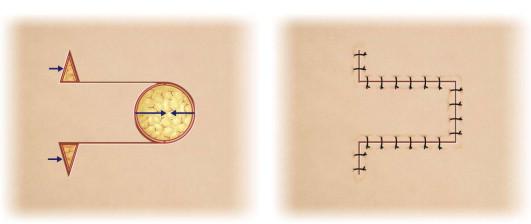
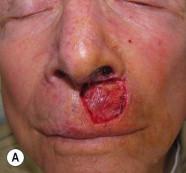
The leading edge of an advancement flap always requires undermining to free deep restraints. Wide undermining of the pedicle base does not necessarily increase mobility because this does little to liberate the lateral, superior, and inferior restraints on flap motion. A pure rectangular advancement flap with a longer length : width ratio is more easily mobilized than a wider flap, and early advancement flap designs were long unilateral advancements with 3 : 1 length : width ratios advocated. These length : width ratios were often touted as appropriate designs to minimize the risks of distal flap necrosis. In reality, it is uncommon to need an advancement flap with such length, and in clinical practice, narrow flaps that are excessively long or sutured under unacceptably high wound closure tensions are no more subject to ischemia than wider flaps created under equally undesirable conditions.
When sufficient tissue laxity does not exist to allow for a simple unilateral advancement flap, a bilateral advancement flap may be designed such that each flap advances half as far to meet in the center of an operative wound ( Fig. 17.3 ). The standard bilateral rectangular advancement flap (known as the H-plasty) is most useful for eyebrow defects, where the horizontal and vertical scars can be hidden adjacent to and within the brow, respectively. Often a unilateral advancement flap with short, broad limbs will suffice to close an eyebrow wound that historically would have been closed with lengthy bilateral advancements. As such, once an H-plasty is designed, it makes sense to elevate one flap side at first to determine whether unilateral tissue movement will be adequate to close the defect before incisions are made bilaterally.
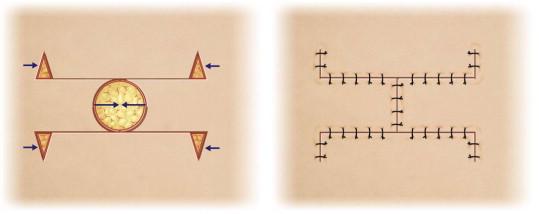
The H-plasty repair has limited applications in other facial locations because of the complexity of the required incision lines. Although the bilateral advancement flap has been historically suggested as an appropriate repair of forehead wounds, the horizontally oriented “H” scar resulting from bilateral tissue advancement is often quite visible. Excision of the dog-ear redundancies that result from tissue advancement further complicates the rather unaesthetic arrangement of the scar. Also, if there is any ischemia of the flap's advancing edge(s), this vertical closure is likely to leave behind a slightly depressed scar. Simpler closures, even a vertically oriented linear repair, are frequently more suitable. If there is sufficient laxity to allow the direct advancement of two adjacent flaps, there is nearly always sufficient laxity to allow a primary linear closure. The surgeon is rewarded for selecting the more appropriate simple linear repair, with simplicity of design and operative ease, and the patient is rewarded with a lower risk procedure, less (if any) sensory loss above the closure, and a more visually pleasing scar.
The standard bilateral T-plasty repair or A–T (A to T) flap can be a great improvement over the unilateral and bilateral rectangular advancement flaps in most facial locations. In the A–T repair, a linear repair of the operative wound is designed perpendicular to a free margin or to a pre-existing cosmetic junction ( Fig. 17.4 ). Instead of extending a primary linear repair across a cosmetic boundary or free margin, incisions are designed along the margin of the operative defect, a free margin, or a cosmetic boundary, perpendicular to the linear repair axis. In this manner, one line of the repair is hidden in a cosmetic junction or dynamic rhytid.
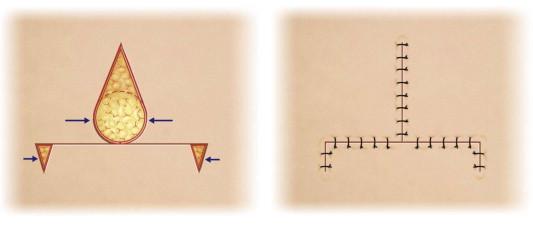
Closely related to the A–T advancement flap is the O–T rotation flap. Conceptually similar, the flaps both create a T-shaped incision. Where the A–T flap relies upon linear tissue advancement, the O–T flap relies upon flap rotation. The A–T flap is useful for perialar defects where the top of the T can be hidden in the alar crease and the vertical limb of the T can be hidden in the nasolabial fold. Above the brow or on the forehead, the base of an inverted T can be hidden either just above or just below the brow or within a horizontal forehead rhytid ( Figs 17.5 , 17.6 ). The vertical scar that results from this repair may be somewhat visible, but it generally fades nicely over time if the flap is not closed under tension. Although the classic A–T flap is rather simplistic from a design perspective, great care must be taken to align the advancing tissue edges. If the leading edges of the advancement(s) traverse a great distance to close a large defect, distracting dog-ear redundancies can be produced. Sometimes, these tissue redundancies need to be excised in the areas that the surgeon was initially reluctant to manipulate, so undermining flap utility. Often, a single limb advancement flap will suffice to displace a dog-ear far away from a free margin into a natural crease ( Fig. 17.7 ). Whenever possible, a single limb advancement flap is favored because its inherent simplicity in design minimizes suture lines.
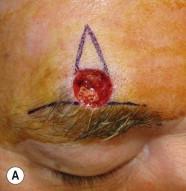
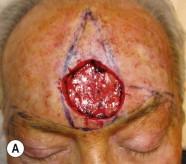
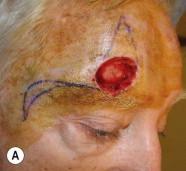
As with all facial flaps, advancement flaps are most useful when the incisions of the flap can be hidden within cosmetic unit boundaries or along natural facial expression lines. Commonly used sites for advancement flaps are the nasal sidewall superior to the alar crease, the upper lateral lip superior to the vermilion border, and the supraorbital forehead lateral to the midpupillary line. For defects in these areas, a vertical limb extends superiorly from the operative defect and a horizontal or nearly horizontal limb extends laterally along a free margin (the alar crease, vermilion border, brow, or forehead furrow). A dog-ear is then removed laterally either within the alar groove or nasal fold, the oral commissure, or the lateral canthus or crow's feet.
This Burow's-type advancement flap can be viewed simplistically as a flap that displaces the inferior dog-ear redundancy that would have resulted from a linear closure to an anatomic site from which it may be much more appropriately excised ( Fig. 17.8 ). A similar advancement modification, first described by Webster, is often used for operative defects of the distal nasal sidewall. In this case, a superior dog-ear is removed nearly vertically, more-or-less parallel to the nasal bridge and nasofacial sulcus, while the inferior limb of the flap curves around the ala as a crescent. A crescent of redundant tissue is removed inferiorly lateral to the alar crease and melolabial fold to allow proper tissue advancement ( Fig. 17.9 ). The concept of the crescentic advancement flap may be extended to other common defects ( Fig. 17.7 ). This technique obviates the need for dog-ear resection because this is accounted for in flap design with a crescent of excess skin to be excised. Removing this crescent of tissue frees the flap from the rigid constraints of geometry and allows the resulting suture line to better conform to curvilinear facial boundaries.
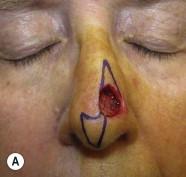
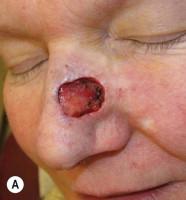
The island pedicle flap is a specialized advancement flap. The island pedicle flap differs from other traditional advancement flaps in that most of its vascular supply derives from a subcutaneous pedicle. Additionally, all dermal margins of the flap are severed as the flap is advanced (hence the appropriate “island” nomenclature). The first island pedicle flap was described by Celsus, but the first modern use of the island pedicle flap was by Esser in 1917. Since the 1940s, many types of island pedicle flaps have been described, the most common of which is a triangular flap that derives its blood supply from a deep and mobile subcutaneous or muscular pedicle, which remains attached to the central portion of the flap. In the plastic surgery literature, this traditional island pedicle flap is frequently referred to as a V–Y advancement flap.
The island pedicle flap is remarkable because the flap can be advanced as far as the motion of the deep pedicle allows. This mobility is frequently much greater than a similarly designed flap would advance if dermal margins that restrain flap motion were retained at the peripheral margins of the flap ( Fig. 17.10 ). In addition, the island pedicle has a rich blood supply from underlying vessels and musculature and is not forced to rely solely upon the anastomotic vascular network of the dermis for perfusion. As such, the island pedicle flap is remarkably impervious to ischemia, even when the flap is inserted under considerable wound closure tension.

Because the traditional island pedicle flap has a conspicuous kite-shaped outline, its greatest use is in locations where one or two of the margins of the flap can be hidden within a contour line or aesthetic unit boundary. Surgical defects on the upper lip near the nose–lip–cheek junction and on the lateral nasal sidewall are particularly well suited for repair with an island pedicle flap ( Figs 17.11 , 17.12 ). Additionally, the island pedicle flap is useful in the reconstruction of the eyebrow, where the flap can advance the remaining brow medially to recreate brow continuity and central facial symmetry.
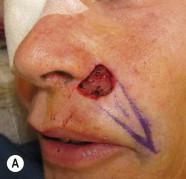
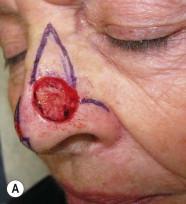
In designing and executing the island pedicle flap, it is essential to predict the amount of mobility that will be achieved when all peripheral margins of the flap have been severed. Two centimeters in diameter or even larger wounds of the perinasal area of the upper lip can be repaired with an island pedicle flap, but in general, defects on the nose amenable to island pedicle flap repairs tend to be smaller (given the poor compliance of stiff nasal skin and the inability to rely on secondary motion at the flap's insertion point without producing distracting nasal asymmetry). The island pedicle flap is particularly well suited to deeper operative wounds because it carries all tissue layers with it, including skin, subcutaneous tissue, and some skeletal muscle. Additionally, the flap's rich vascular supply makes it appropriate for repairs in areas of compromised skin vascularity (such as areas of chronic radiation damage).
Proper design and execution of an island pedicle flap are necessary for an aesthetic repair. Because the flap has a thick base, it is particularly subject to developing a protuberant appearance (the pin-cushioned or trapdoor deformity) during the early postoperative period. The development of the trapdoor deformity with this flap is more common when the flap is used to repair wounds on the medial cheek and lip, and this globular appearance may be permanent. One solution may be to design a flap that has a smaller breadth than the diameter of the primary surgical defect and will still generally allow for closure of the operative wound by relying upon secondary motion of the skin edge of the wound. This slight undersizing of the flap places modest wound tension on the lateral aspects of the island pedicle flap, which theoretically diminishes postoperative contraction of the flap and the risk of developing a subsequent trapdoor deformation. The flap is incised with either strictly vertical incisions or with slightly outwardly beveled incisions that include the adjacent deep subcutaneous fat or underlying muscle. The peripheral margins of the flap's incisions are widely undermined, as is the primary defect. The tapering tail (approximately the distal third) of the flap must be freed completely from any lateral or deep restraint, either by blunt or sharp undermining. This tethering of the tail of the flap is usually the primary area of restraint that inhibits the flap's mobility.
Because the flap must be deeply undermined vertically but not across its base to allow proper flap mobility, a thorough knowledge of the underlying anatomy is required. This undermining is generally carried out just over the superficial fascia. In addition to freeing the flap's tail, the surgeon may need to undermine the leading edge of the island pedicle flap to some extent (rarely >1 cm) to allow the flap to advance with minimal wound closure tension and to prevent inversion as a result of tethering of the leading edge. Failure to minimize the flap tension can result in unanticipated and undesirable secondary motion near the flap's insertion point. In critical areas, such as along the free margin of the eyelid, this secondary motion can produce aesthetically significant distortion (e.g., an ectropion).
The flap itself should be inset slightly into the operative defect and secured with several deep sutures, and a flap that is initially slightly concave will eventually heal as a flap that is appropriately flush with the surrounding skin. This flap recession can be routinely achieved, as mentioned above, by slightly undersizing the flap and by suturing the flap under slightly increased wound tension.
In addition to the traditional design, many variants of the island pedicle flap have been discussed in the reconstructive literature. Curved island pedicle flaps can be particularly useful on the nose, where the incision lines can be placed along the alar groove. De-epithelialized flaps or even flaps that have the entire pedicle buried in a subcutaneous tunnel can occasionally be quite useful in the repair of deep nasal or medial canthal wounds. Regardless of the design nuances, all island pedicle flaps have as their chief advantage a healthy and protected vascular supply.
For operative wounds restricted to the glabrous portion of the pink lip, repair choices are often limited. Partial-thickness wounds that do not cross the vermilion border can be allowed to heal by second intention with minimal scarring. For broader wounds, an advancement flap from the remaining intraoral mucosa is often an appropriate repair. The mucosal advancement flap is designed so that the incision line traverses the entire horizontal length of the border between the cutaneous and the mucosal portions of the lip ( Fig. 17.13 ). The flap is incised, and undermined between the plane of the minor salivary glands and the underlying orbicularis oris musculature. This undermining plane protects the perfusion of the flap while preserving the function of the underlying muscle. The flap is sharply undermined from anterior to posterior, following the natural curvature of the lip. Extensive undermining may be necessary into the intraoral mucosa to achieve proper flap mobility; undermining is generally extended to the area where the mucosa reflects onto the mandible. Using the principles of simple tissue advancement, the generously liberated flap can then be advanced to cover even broad wounds on the lower lip. Because the actual length of tissue advancement is relatively small and because the mucosa is quite forgiving, dog-ear redundancies that result from tissue advancement are not typically significant enough to require complete removal. Although the incision scar of the mucosal advancement flap is often quite subtle, the modest tension required to advance the flap typically results in a slightly flattened appearance of the lower lip.
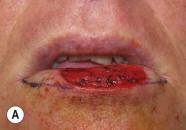
Alternatively, an island pedicle flap can be designed by advancing mucosal skin anteriorly to fill full-thickness defects of the pink lip that do not cross the vermilion border. Advancement must proceed with minimal tension in the direction of primary movement or lip distortion ensues. One adverse effect of moving mucosal lip onto the exposed pink portion of the lip is long-term peeling of this new lip skin as a result of metaplasia.
Become a Clinical Tree membership for Full access and enjoy Unlimited articles
If you are a member. Log in here